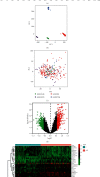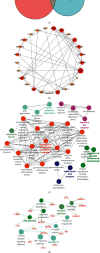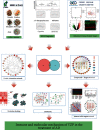Active Compounds and Targets of Yuanzhi Powder in Treating Alzheimer's Disease and Its Relationship with Immune Infiltration Based on HPLC Fingerprint and Network Pharmacology
- PMID: 35873623
- PMCID: PMC9307349
- DOI: 10.1155/2022/3389180
Active Compounds and Targets of Yuanzhi Powder in Treating Alzheimer's Disease and Its Relationship with Immune Infiltration Based on HPLC Fingerprint and Network Pharmacology
Abstract
Background: Yuanzhi powder (YZP) has been extensively investigated as a natural prescription with therapeutic benefits for Alzheimer's disease (AD). However, its active compounds and underlying immune mechanism for treating AD are still unclear. This study aimed to investigate the immune mechanism of YZP against AD through high-performance liquid chromatography (HPLC)-based network pharmacology and gene chip technology.
Methods: Active components of YZP were obtained from HPLC and public databases. Subsequently, GSE5281, GSE28146, GSE29378, and GSE97760 from the Gene Expression Omnibus (GEO) database were downloaded to extract AD difference genes (DEGs). The active components-targets network and protein interaction network were then constructed by Cytoscape. The biological processes and signaling pathways, which implicate the targets of YZP for AD, were analyzed using the ClueGo Cytoscape plug-in. Molecular docking experiments were performed to verify the affinity of targets and ligands. Ultimately, the link between the hub genes and immune cell infiltration was assessed via CIBERSORT.
Results: 83 YZP active compounds and 641 DEGs associated with AD, including quercetin, berberine, 3,6'-disinapoylsucrose, coptisine, and palmatine, were evaluated. We showed that FOS, CCL2, and GJA1 were the core targets and that the gap junction is an essential signaling pathway in YZP for AD. Furthermore, the AD group had a higher infiltration level of naïve B cells and resting CD4 memory T cells, as determined by the CIBERSORT. Notably, the immune cells-targets network demonstrates that GJA1 and GRM1 are intimately related to naïve B cells and plasma cells.
Conclusions: YZP may help treat AD by targeting proteins with key active compounds to regulate naïve B cells and plasma cells. Our results demonstrate a new immune mechanism for treating AD with YZP.
Copyright © 2022 Qingsong Liu et al.
Conflict of interest statement
The authors declare that they have no conflicts of interest.
Figures






Similar articles
-
Yuanzhi Powder inhibits tau pathology in SAMP8 mice: Mechanism research of a traditional Chinese formula against Alzheimer's disease.J Ethnopharmacol. 2023 Jul 15;311:116393. doi: 10.1016/j.jep.2023.116393. Epub 2023 Mar 29. J Ethnopharmacol. 2023. PMID: 37001766
-
Network Pharmacology-Based Strategy to Investigate the Pharmacologic Mechanisms of Coptidis Rhizoma for the Treatment of Alzheimer's Disease.Front Aging Neurosci. 2022 Jun 21;14:890046. doi: 10.3389/fnagi.2022.890046. eCollection 2022. Front Aging Neurosci. 2022. PMID: 35795239 Free PMC article.
-
Identification of diagnostic signatures associated with immune infiltration in Alzheimer's disease by integrating bioinformatic analysis and machine-learning strategies.Front Aging Neurosci. 2022 Jul 29;14:919614. doi: 10.3389/fnagi.2022.919614. eCollection 2022. Front Aging Neurosci. 2022. PMID: 35966794 Free PMC article.
-
Identifying the Mechanisms and Molecular Targets of Yizhiqingxin Formula on Alzheimer's Disease: Coupling Network Pharmacology with GEO Database.Pharmgenomics Pers Med. 2020 Oct 15;13:487-502. doi: 10.2147/PGPM.S269726. eCollection 2020. Pharmgenomics Pers Med. 2020. PMID: 33116763 Free PMC article.
-
Integrated analysis and identification of hub genes as novel biomarkers for Alzheimer's disease.Front Aging Neurosci. 2022 Aug 30;14:901972. doi: 10.3389/fnagi.2022.901972. eCollection 2022. Front Aging Neurosci. 2022. PMID: 36110430 Free PMC article.
Cited by
-
Identification of diagnostic genes for both Alzheimer's disease and Metabolic syndrome by the machine learning algorithm.Front Immunol. 2022 Nov 2;13:1037318. doi: 10.3389/fimmu.2022.1037318. eCollection 2022. Front Immunol. 2022. PMID: 36405716 Free PMC article.
-
Exploring the molecular mechanism of Gan Shuang granules for the treatment of non-alcoholic steatohepatitis using network pharmacology, molecular docking, and experimental verification.Front Pharmacol. 2023 Jan 24;14:1082451. doi: 10.3389/fphar.2023.1082451. eCollection 2023. Front Pharmacol. 2023. PMID: 36762105 Free PMC article.
References
LinkOut - more resources
Full Text Sources
Research Materials
Miscellaneous

